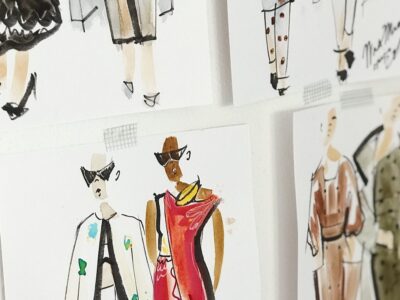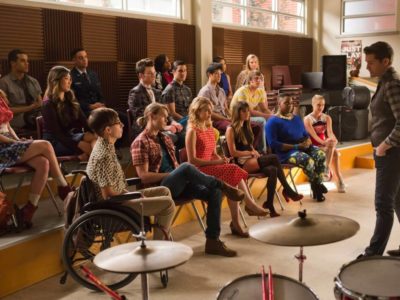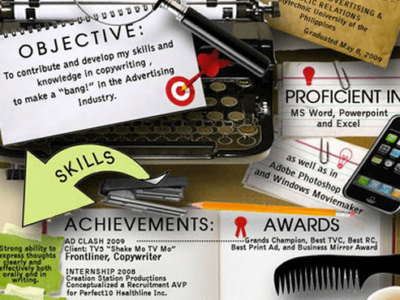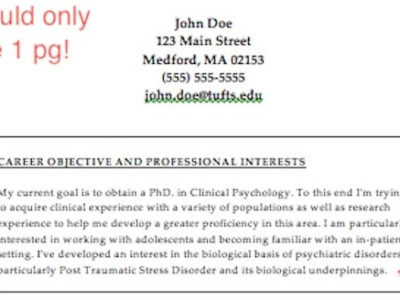Fashion influences plenty of our daily lives and so does Meryl Streep in her role as Miranda Priestly, Anne Hathaway’s haughty editor-in-chief in the 2006 comedy The Devil Wears Prada. Like Andrea Sachs, Hathaway’s character, none of us want to bore our future employers with our incompetence. If you can’t wait to hit the runway, you’ll want to know how to spice up your resume before you sell your soul to the devil for a pair of Jimmy Choo’s.
Check out 10 ways you can spice up your fashion resume that’ll leave even Miranda Priestly’s head spinning:
1. Show some skills

When it comes to any job, skills emphasize your ability to get the job done well. In industries like fashion, your work depends upon your skills. Consequently, your skills help determine your career and employment. For that reason, exemplifying your skills on your resume will show the hiring managers why they should hire you and what you have to offer. And, of course, skills come in a variety.
“To be successful in fashion, students need to demonstrate both hard and soft skills, not just list them,” Arizona State University professor Danielle Testa explained. “At an early point in your career, skills are important and show your potential.”
Demonstrating your skills (and don’t just list them on your resume) because of their great value to the fashion industry. Include hard skills like advanced Excel formulas, hand illustration and tech packs in the descriptions of experiences. For soft skills, list them as well but make sure to show them in your experiences.
2. Get some experience – as soon as possible!

This might seem like a no-brainer, but it remains one of the most important aspects of a resume. Experience in the fashion industry can go a long way, leading to connections and references for the future. However, that brings us to the long-awaited question: what kind of experience?
“It’s important to tell your employers what experience you have, because that experience might just be what they’re looking for,” Arizona State sophomore Peyton Hurlbert said. “And if you don’t have a lot of experience, don’t fret. Rather than not seeming confident and stressing how you don’t have much experience, it’s important to emphasize the experience you do have, even if that’s just designing in your sketchbook. Experience is experience!”
Getting experience illuminates the skills you possess; internships attest to that. They’ll help you gain the experience you need, in any fashion job, from creative design to merchandising. Include any creative jobs, experiences related to the fashion industry, or even jobs where you worked in a team. If you have many to choose from, pick what constitutes as the most relevant. If you find yourself with limited experience, include any campus activities, events, volunteer experiences (from high school and university) or clubs or organizations that would help display your skills.
3. No photos

If you wanted to put a pretty picture of yourself on your resume, do not. Photos can create bias and go as far as to distract your potential employer from the important matter at hand: your skills. For this reason, employers avoid resumes that include photos in fear of distraction and/or discrimination. Resumes should portray professionalism and your experiences. So, more often than not, resumes with photos get tossed.
“HR departments and hiring managers are looking to hire on merit, not appearance,” Testa said. “Including photos does not provide any evidence of a student’s skillset or suitability for a job.”
Instead of a photo, go into depth when describing some of your experiences or skills. Try to make sure you have absolutely everything your future employer will want to see. Make an attempt at being professional and concise. Remember to show your skills! To make your resume stand out, let your personality shine through without a picture
4. References

Most entry level positions don’t require references and you won’t need them until later in your career. However, that doesn’t mean references won’t give you an advantage. They can help you score an interview and aid you in developing a feel for what the brand or your employer wants. All in all, references can’t hurt your chances at scoring the job.
“If it can get you an extra step ahead, then get as many as you can,” Hurlbert said. “Being referenced by another fashion designer can give you a higher chance of leading your employers to look into your application.”
If you can, try to include references from one professor or instructor, managers, industry references, and of course, any fashion designer you may have interned for. References have the ability to get you ahead of the game, even if it might not seem like it. After all, Miranda Priestly did give Andy the reference she needed. Of course, she did so in true Miranda Priestly fashion, with a rather snide comment.
5. Just a little bit of tweaking

Just how you write multiple drafts of an essay or article, you’ll want to write at least one draft for your resume. At the very least, you’ll want to edit it before submitting. Design your essay for the job you plan on applying for. Not all employers want the same thing, and therefore, your resume should reflect what they need.
“At the very least, cater the type of job you are looking for,” Testa said. “Resumes should be adjusted to each job you apply to— they are not one size fits all.”
In the “about” section or “objective” section in your resume, make sure to emphasize detailed interests, the sort of job you want, and what you can bring to their company. If you just want a job and don’t know what you want to do yet, don’t disclose that information. If this seems stressful, don’t worry. Show your employers that you have the confidence they need and that, more importantly, they need you.
6. Previous jobs

When it comes to jobs, make sure to list any involving event planning or campus publications, as well as any volunteering you could have done at fashion shows on your resume. Some highly valued positions include any jobs in retail, which remain very important. However, make sure to avoid restaurant experience (unless you worked as a shift manager or higher).
“Something they [students] should leave out is work experience that holds no relevance to the fashion industry or something you could utilize in the job you’re applying,” ASU sophomore Caitlin Carmendy said. “Something they should definitely include is any unique classes or courses they may have taken for specific techniques that relate to fashion design.”
Some jobs, like waitressing, won’t stand out on your resume. In many industries, including fashion, it seems as if everyone has had a job as a server. List jobs on your resume that will stand out! Make sure to focus on positions and experiences that display your skills and zeal.
7. Traditional v. Creative Resumes

If you’ve never written or formatted a resume, stop to consider the sort of format you want to use: the traditional or creative resume. Traditional resumes, which can be formatted and created using Microsoft Word, consist of a single column, black text, white background, name, contact information, education, work experience, extracurriculars and skills. Creative resumes, on the other hand, have colored text/background and two columns. The first indicates your name, contact information, profile/objective. The second, wider column includes education, work experience, extracurriculars, and skills.
“Large companies prefer the traditional format. This is easier for their algorithms to search and extract key information and also for hiring managers to review quickly since they receive hundreds of applicants per job. This is the format I recommend to students and preferred when I was a hiring manager at a global brand,” Testa said. “However, small businesses often like the creative resume. They show a bit of personality and small businesses like that. Small businesses also are less likely to use algorithms to extract key information for the first review, so the traditional format isn’t as important.”
Try to cater the format of your resume to the sort of company or business you plan to apply to. Figure out what your future employer wants and apply the correct format. Remember that you can still show your creativity and personality through a traditionally formatted resume! Show your skills through your job descriptions, experiences, and skills.
8. Portfolio

While experience attests to your skills, your portfolio will amplify them. Students should begin to curate their portfolios almost immediately. Once you develop the work to demonstrate your skills, start putting together a portfolio. Taking part in internships while in college serve as great ways for fashion students to gather experience and add to their portfolio
“As you advance in school you can take out older work if your skills have drastically advanced, but the more experiences you get during college the more likely you are to find the right opportunity when you graduate,” Testa said.
Make sure that your work showcases your knowledge, talents, creativity, and of course, skills. Keep a great collection of your work and pick the best, catering to the specific job. Have some fun with it! As you create, set aside work to include in your portfolio. A good portfolio can go a long way.
9. Bullet points everywhere

An important detail to consider when formatting your resume lies in the world of bullet points. Not only do they appear easy on the eyes, but they remain clear and concise in comparison to long-winded paragraphs. List each job and extracurricular with a bullet point, followed by a brief description. Remember to use action words that connect to soft skills.
“Remember that HR and the hiring managers will be reviewing a lot of resumes so they will not read any novels,” Testa said.
In doing so, she advises students to start with five bullet points and end with two. To make it even more concise, have them not extend past one line. Avoid paragraphs and keep it simple. Make sure to list any experiences specific to the job!
10. Internships

The easiest way to gain experience lies in the art of internships. In the fashion world, a plethora of jobs remains available to you. And with them, connections. Internships and the connections that come with them can provide you with references for any future position. After all, networking can influence much of your work and career (think of Andrea Sachs!).
“Even if you know what type of job you want, it is important to understand the job role might be completely different from one company to another,” Testa said. “Internships give you experiences not only to learn, but also to find the right job fit for you.”
“The best way to prepare for a career in the fashion industry is to make connections with every opportunity possible. Like many other fields of work, connections are vital and can help you improve your skills while also giving you career opportunities,” Carmendy adds. “Take all the advice you can get and remember that there is always room for improvement.”
“No one is ever 100% ready for their career because it’s a life-changing thing; this could be the rest of your life,” Peyton said. “It’s a huge weight to carry, so don’t let that hold you back from starting out. You’ll never know how it goes if you don’t take the first step!”
If this guide makes you feel all sorts of stressed and worried, take a deep breath. You’ve reached the end! Remember to take any opportunities that present themselves; you never know what could come out of it. Most importantly, don’t forget to show your unique skills and display your confidence.
In the words of Miranda Priestly, “That’s all”.



















